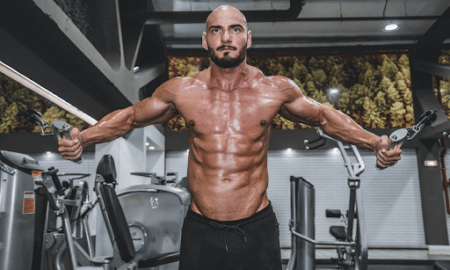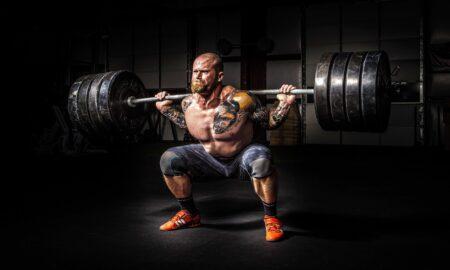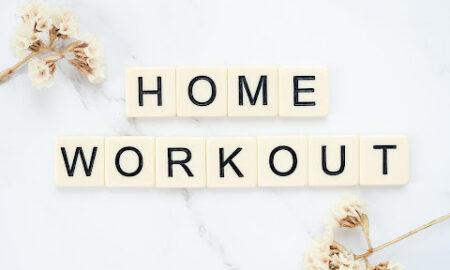It was Saturday, four weeks since I’d seen Arnie. I dropped by the gym while he was working out. After we exchanged greetings, I quizzed him about his follow-up to my recommendations.
He’d used www.CalorieKing.com to work out his average daily calorie intake—2,350. Because the quantity of food he was having was typical of what he’d been eating for a good while—the individual foods had changed—and his bodyweight had been stable, we took 2,350 as his maintenance intake for his current activity level and bodyweight. (Yours is likely to be different).
Now that Arnie was training hard and in potential growth mode, he needed more calories and nutrients. I didn’t want him to increase his food excessively, though, because I didn’t want him to get so bulk-focused that he’d add more fat than muscle. Letting a little fat accompany a lot of muscle, however, is acceptable—perhaps even necessary for many bodybuilders.
While he’d added 300 or so calories to his daily diet, Arnie had to keep training hard and progressively in order to produce the stimulus for muscle growth. Without that stimulus, the extra calories would be stored as fat.
He’d added a little extra food to some of his meals and had a meal every three hours or so. He also had a pint of semiskim milk about 15 minutes after each workout, with a couple of spoonfuls of protein powder or skim-milk powder mixed into it. He takes the drink to the gym premixed in a thermos.
Following the dietary adjustments, Arnie had gained two pounds of bodyweight over four weeks, and his waist hadn’t increased. That was perfect.
Now that he was four months into the program, as I explained in the first installment of this series, I wanted to make some training adjustments, but I wasn’t going to mess with the overall format because it was working well.
I instructed him to reduce his reps to six on deadlifts, bench presses, pulldowns, dumbbell presses and incline curls. Three work sets of each exercise still made sense. He was still supposed to use the same weight for a given exercise for all three work sets and not rush between sets. The first set would still feel easier than the third. Only when he made all three work sets for the required reps for a given exercise would he be entitled, next time, to add the smallest weight increment the gym had.
I’d brought Arnie his own little gems—two pairs of half-kilo plates and two pairs of quarter-kilo plates—with his name engraved on them. Where he trains, 1 1/4-kilo and
2 1/2-pound plates are the lightest but are not light enough. The microweight plates I got him would enable Arnie to make poundage progression one nudge at a time.
He was keeping a training log and continued to stretch after each workout for 15 minutes, but he still wasn’t doing any cardio.
I now moved Arnie up to barbell squats. He’d continue with the leg press at his Saturday workout, but on Tuesday he’d squat rather than leg-press. Arnie’s body structure is suited to the barbell squat. For bodybuilders whose legs are long relative to their torsos, the barbell squat isn’t recommended. The leg press is a safer, more productive exercise for them, as is—usually—the parallel-grip deadlift.
On the Saturday before Arnie’s first squat session, I came by to teach him the basics. I had him do some squats without any weight. He showed me the sort of technique he’d seen at the gym—his feet were closer than hip width and parallel to each other. As a consequence, his form was cramped and awkward, and he wasn’t stable on his feet.
I got him to widen his stance to about hip width and flare his feet. He tinkered with the width and the flare until he got a combination that felt comfortable and natural for him, and that easily kept his feet flat on the floor and stable. He now had the space to squat into, and he immediately looked like a decent squatter. He leaned forward as he squatted—as everyone must on the barbell squat—but not excessively. His back easily stayed slightly arched even at the bottom position, where his upper thighs were parallel to the floor.
Arnie then went into the squat rack. I had him place an empty 20-kilo bar on the contracted muscle immediately above his shoulder blades. Then, while keeping his lower back slightly arched and the muscles in his entire back contracted, he shuffled backward from the bar holders and adopted the correct stance that he had discovered while doing the freehand squat.
I had him use a controlled rep speed—no faster than two seconds down and another two seconds up. He paid special attention to keeping his chest puffed out as he rose from the bottom position. I stressed that his hips must never rise faster than his shoulders.
Arnie could descend deeper than to the parallel position, but that would flatten and then round his lower back. The parallel position would suit him perfectly.
He would squat on Tuesdays instead of the leg press but take it easy at first in order to get into the groove of correct technique. His Saturday leg pressing would remain his only demanding thigh exercise for the time being. It would be more than two months before the squat would become taxing.
Beginner’s Bliss continued to work its magic, and Arnie was further on his way to becoming big.
—Stuart McRobert
www.Hardgainer.com
Editor’s note: Stuart McRobert’s first byline in IRON MAN appeared in 1981. He’s the author of the new 638-page opus on bodybuilding Build Muscle, Lose Fat, Look Great, available from Home Gym Warehouse (800) 447-0008 or www.Home-Gym.com.




















You must be logged in to post a comment Login